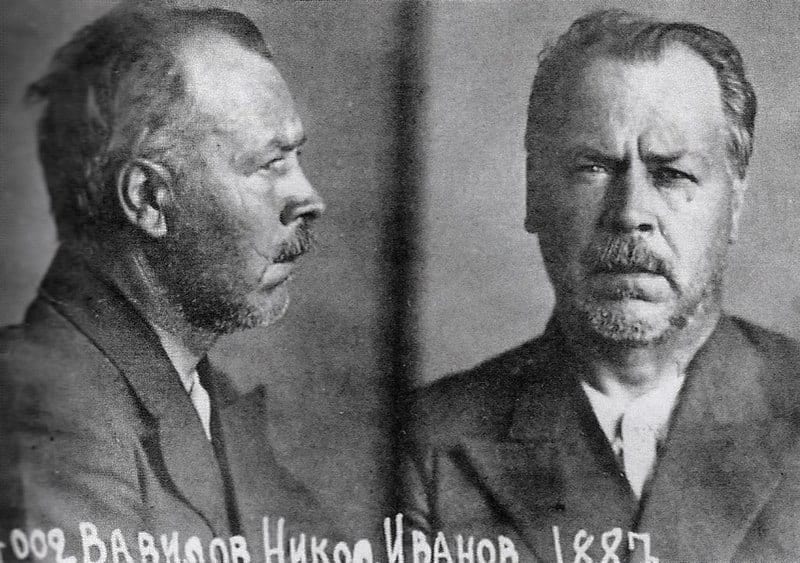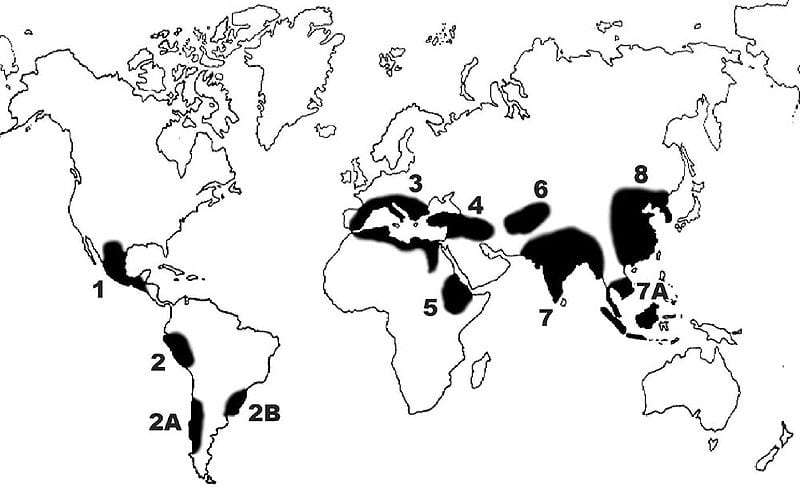The imposing structure of the Svalbard seed bank is familiar to many. This “doomsday†vault (ahem, already breached by climate change) is humanity's last resort for preserving the seeds of our crops and plants. But how did this bastion of biodiversity arise?

Nikolai Vavilov, a 20th century Russian agronomist and geneticist, established the first modern seed bank in Leningrad in 1921. He is best known for establishing the centers of origin for the world's cultivated plants. These are the geographical locations where the world's major crops were domesticated, critically containing the wild relatives and greatest amount of genetic diversity for these plants. So while Vavilov traveled the globe (primarily on mule), he collected seeds to bring back to his native Russia in an effort to create a genetic repository to combat global hunger. He ended up collecting more seeds than any other person in history, eventually amassing some 250,000 entries in Leningrad. In a gutting twist, he became a martyr for plant genetics, dying in jail from starvation after being imprisoned for espousing Mendelian ideals while anti-Mendelian concepts were favored in Stalin's Russia.

After Vavilov's imprisonment, a dedicated staff of scientists maintained the seed bank at the Institute of Plant industry. During the Siege of Leningrad in 1941, they barricaded themselves inside the seed vault to protect this valuable biodiversity from both the German army and starving Soviet citizens. A dozen scientists starved to death guarding the seeds, which could have sustained them. Ensuring the food security of future generations was deemed more important than their own livelihoods.
Fast-forward to the 21st century and Vavilov's original seed bank is now accompanied by upwards of 1400 other seed banks around the globe. But, the path to seed bank proliferation is a complicated one. With improved understanding of plant genetics in the 20th century came the advancement of high-yielding, stable crop cultivars, particularly hybrid varieties. These modern plant varieties are highly uniform and in the case of hybrid seed, genetically homogenous, which differs from historically predominant landrace varieties. As a contrast, landraces are traditional varieties that have adapted to their localized environment through domestication and are much more genetically variable- this is what Vavilov was amassing in his collection. However, the modern varieties were so high-yielding that they were spread throughout the globe as a means of combating hunger during the Green Revolution. Scientists quickly began to note that the new cultivars were effectively displacing local varieties of crops, causing variety extinction and contributing to genetic erosion, or the loss of genetic diversity. Genetic diversity is key to increased food security; landraces and wild relatives of cultivated crops often possess crucial traits such as disease or pest resistance, which can be used to improve the germplasm of current cultivars. So while plant breeders were capitalizing on the genetic diversity of landrace varieties to develop high-yielding, stable cultivars, the subsequent proliferation of those cultivars was wiping out that very same genetic diversity that they relied on. The imperative of seed banks soon became maintenance of crop biodiversity, rather than the straightforward catalog of diversity that Vavilov had conceived. Cue the Svalbard Global Seed vault.

Further complicating things is the idea of ownership of this banked biodiversity. For most of history, the world was functioning under a “common heritage†assumption of genetic resources, meaning that they were a public good that could be availed of freely. Meanwhile, over the past few decades, the idea of ownership of genetic materials shifted with the offering of patents for stable cultivars and genetically engineered material. So by the late 20th century we had a free flow of plant genetic resources (PGR) to breeders, but a flow of patented, costly seed coming out of breeders. Much of the Earth's plant biodiversity exists in the developing world (remember Vavilov's centers of origin?) while much of modern plant breeding infrastructure exists in the developed world. To many in the developing world, this reeked of imperialism and was hotly protested. After years of pressing this case, some national sovereignty over PGR was granted with the 2001 International Treaty on PGR for Food and Agriculture. This established a shared benefits dimension to PGR, in which countries receive a portion of the profits from anything derived from their PGR.
The implications of this biodiversity privatization are nuanced. Often, we are still left with costly seed that may be beyond the reach of low-income farmers. In certain economically precarious contexts, this cost is associated with the perturbing phenomena of farmer suicides. This protectionist institution may not be the same one that Vavilov and his associates died for.
About the Author
 Tara Conway Tara Conway is an M.S. student in Crop and Soil Sciences, where she is working towards the development of a perennial grain sorghum. She is originally from Chicago, IL. Her work experience spans from capuchin monkeys to soap formulating. You can reach her at tmc66335@uga.edu, where she would like to know which bulldog statue in town is your favorite. Hers is the Georgia Power one due to its peculiar boots. More from Tara Conway.
Tara Conway Tara Conway is an M.S. student in Crop and Soil Sciences, where she is working towards the development of a perennial grain sorghum. She is originally from Chicago, IL. Her work experience spans from capuchin monkeys to soap formulating. You can reach her at tmc66335@uga.edu, where she would like to know which bulldog statue in town is your favorite. Hers is the Georgia Power one due to its peculiar boots. More from Tara Conway.
About the Author
Tara Conway Tara Conway is an M.S. student in Crop and Soil Sciences, where she is working towards the development of a perennial grain sorghum. She is originally from Chicago, IL. Her work experience spans from capuchin monkeys to soap formulating. You can reach her at tmc66335@uga.edu, where she would like to know which bulldog statue in town is your favorite. Hers is the Georgia Power one due to its peculiar boots. More from Tara Conway.
- Tara Conwayhttps://athensscienceobserver.com/author/tara-conway/March 13, 2020
- Tara Conwayhttps://athensscienceobserver.com/author/tara-conway/September 30, 2019






